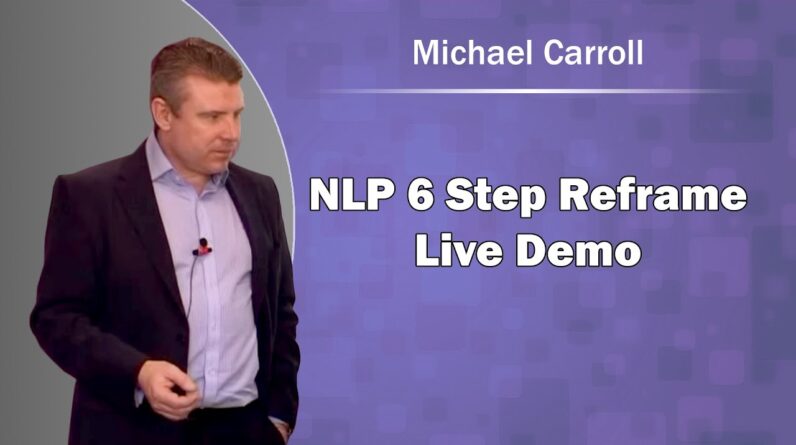
Neuro-Linguistic Programming (NLP) is a powerful technique gaining popularity in the self-improvement industry. It enables individuals to reframe limiting beliefs and internal conversations, fostering positive thoughts and behaviors. In this comprehensive guide, we will take you through a step-by-step process of NLP’s 6-step reframing. By following these steps, you can transform your limiting beliefs and internal dialogue into empowering beliefs and productive behavior.
Step 1: Identify the Area Where You Want More Choice
To begin, identify the area in your life where you desire more choices. This could relate to relationship issues, career challenges, health concerns, or any other aspect you feel limited in terms of choices. Close your eyes, visualize the situation where you feel stuck, and ask yourself, “What area of my life do I feel limited in terms of having choices?”
Step 2: Focus on Your Internal Sensations
In the second step, focus on your internal sensations. With your eyes closed, pay close attention to how your body feels. Notice any physical experiences such as a tightening stomach, an increased heart rate, or any other sensations that arise.
Step 3: Ask Your Unconscious Mind to Provide a Signal for “Yes”
Next, ask your unconscious mind to provide a signal for “yes.” Pose the question, “What is my signal for ‘yes’?” Your unconscious mind will respond with physical sensations like a tingle or warmth, indicating a positive response.
Step 4: Ask Your Unconscious Mind to Generate Four New Choices
In the fourth step, ask your unconscious mind to generate four new choices that align with the positive intention of your current choices. Inquire, “What are four other ways I can have positive choices in this scenario?” Allow your mind to explore alternative possibilities.
Step 5: Wait for Your Unconscious Mind to Signal the Discovery of New Choices
Patience is key in the fifth step. Wait until your unconscious mind signals that it has found the new choices. You will receive a signal for “yes” once your mind has completed the task.
Step 6: Confirm Alignment with Personal Integrity and Values
In the sixth and final step, confirm with your unconscious mind that the new choices align with your personal integrity, values, and goals. Ask yourself, “Are these new choices in line with my values, beliefs, and goals?” Ensure that there is no conflict and that the new choices maintain your personal integrity.
Conclusion
During a live NLP demo, participants like Natalia and Matt received clear signals from their unconscious minds. This clarity and relief allowed them to move forward with conviction in their choices. It is important to recognize that current behaviors have a positive intention, and the new choices satisfy that intention. Fear and insecurity should not drive these choices; instead, they should stem from positive motivations.
The NLP practitioner may try different methods to assist individuals who initially do not receive clear signals. This can involve shifting focus from internal sensations to external factors or utilizing alternative language patterns to engage the unconscious mind.
Furthermore, it is crucial to emphasize that the new choices should be as good as or better than the current set of choices. They should never compromise your values, beliefs, or integrity. The process highlights the importance of sensory awareness and being fully present in the moment.
Taking responsibility for implementing the new choices is essential. NLP empowers individuals to become agents of change in their lives by encouraging personal integrity and a sense of accountability.
In conclusion, NLP is an effective technique for personal growth and self-improvement, allowing individuals to reframe limiting beliefs and internal dialogues into positive thoughts and behaviors. The 6-step reframing process, demonstrated through live NLP demos, offers a valuable tool for gaining clarity, developing new choices, and taking empowering actions. By engaging in a series of questions and signals, you can embark on a journey of personal transformation and self-improvement.
FAQs
Q: What is Neuro-Linguistic Programming (NLP)?
NLP is a technique used to reframe limiting beliefs and internal conversations, promoting positive thoughts and behaviors.
Q: How effective is NLP in personal growth and self-improvement?
NLP is a highly effective technique for personal growth and self-improvement. However, its effectiveness depends on individual commitment and willingness to change.
Q: Can anyone use NLP?
Yes, anyone can use NLP. However, it is recommended to seek professional help or guidance from an expert.
Q: How long does it take to see results from NLP?
Results from NLP vary from person to person, but most individuals report experiencing a sense of clarity and relief almost immediately.
Q: Does NLP compromise personal integrity or values?
No, NLP does not compromise personal integrity or values. The new choices generated through NLP must align with personal integrity and values.





